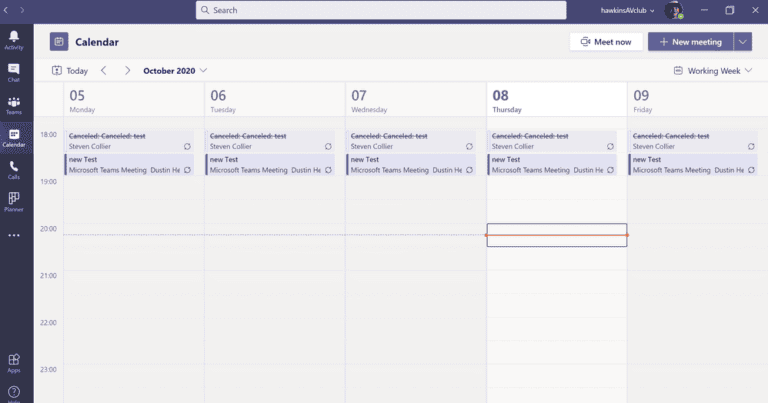
Microsoft recently faced a major disruption due to a global outage caused by a routine software update from CrowdStrike, a cybersecurity company, which unexpectedly affected its services. As a result, corporate email servers, productivity tools, and essential business applications all went down at once. Emails vanished, programs wouldn’t open, and millions of users suddenly found their digital activities halted.
This issue was not a cyberattack. Instead, it was a clear case of the “butterfly effect” in technology. A mistake in CrowdStrike’s software update, designed to enhance security, led to widespread problems, causing Windows systems around the world to crash. The disruption extended beyond emails; airlines experienced flight delays, and global supply chains, financial institutions, and emergency services also faced chaos. This illustrates how a single error can ripple through a connected system, revealing the risks of relying on centralized digital infrastructure.

Social media lit up with #MicrosoftOutage trending globally. Users who were frustrated took to platforms like Twitter and Reddit to express their complaints. However, this outage also highlighted a more serious issue: our heavy dependence on cloud services. With Microsoft 365 having over 345 million paid users, even a few hours of downtime had significant consequences.
This event also emphasizes the fine line between security and stability. Cybersecurity companies like CrowdStrike are vital for our online safety, but even good updates can lead to serious problems. It reminds us how complicated software development is and why thorough testing and backup systems are essential. Experts have long warned about “concentration risk,” meaning the danger of relying too heavily on a few major tech companies. This outage will spark more discussions on that topic.
As Microsoft worked to resolve the issue, users sought alternatives. Many used mobile email apps or web versions of their tools, showing the need for backup plans. Whether you are an individual or a business, the main takeaway is clear: diversify your technology and keep offline backups of important data.
Beyond the immediate impact, this serves as a wake-up call. Our online lives depend on a fragile and complex system, and when one part fails, the effects can be large. As AI, cloud computing, and connectivity grow, building resilience and having backups should be top priorities. This wasn’t just a glitch; it was a warning about the risks of trusting a digital world that may be more fragile than we think.
Key Takeaways
- Microsoft experienced a major global outage affecting email and app access.
- Users turned to social media to express their frustration and find solutions.
- Microsoft is working on restoring services while highlighting tech platform dependencies.
Overview of the Microsoft Outage
A major outage impacted Microsoft services, causing users to be locked out of critical applications like Outlook and Teams. This disruption affected various sectors, including banks and airlines, leading to widespread inconvenience.
Initial Reports and User Complaints
On January 13, 2025, users began reporting issues accessing Microsoft 365 applications. Many found themselves unable to log in, which halted their work and communication. Social media and tech forums quickly filled with complaints, highlighting the importance of these services in daily operations. Users expressed frustration due to the lack of clarity in communication from Microsoft during the incident.
The Multi-Factor Authentication (MFA) system was identified as the source of the problem. This essential security feature malfunctioned, leading to users being locked out. This kind of outage highlights the vital role of security features and the broader impact when they fail, affecting not just individuals but entire organizations.
Scope and Scale of Impact
The outage was significant, affecting users across North America and Europe. The disruption extended to major sectors, including banking, travel, and media. Airlines experienced delays and cancellations, impacting thousands of passengers globally. Other critical services like banks and hospitals also faced challenges, complicating their operations.
Microsoft 365 apps, including SharePoint and OneDrive, went offline, leaving businesses and individual users struggling. The outage demonstrated the dependency many sectors have on Microsoft’s services. It also brought to light the need for robust backup plans when such essential services go down, ensuring continuity in critical operations.
Technical Analysis
Recent events have shown that Microsoft’s systems are not immune to technical difficulties. Users around the world experienced disruptions, causing significant challenges in accessing emails and applications. This analysis explores the potential causes and the complexity involved in resolving such outages.
Possible Causes of the Outage
One key issue was the failure of Microsoft’s Multi-Factor Authentication (MFA) system, which left users unable to access their Microsoft 365 accounts. The technical glitch seemed to affect various services such as Outlook, Teams, and OneDrive.
Technical experts are speculating that a recent update might have inadvertently led to authentication problems. Network issues or server overload are also possible factors that could have compounded the situation. The use of vague technical language by Microsoft during the crisis drew criticism from users, emphasizing the need for clearer communication during technical difficulties.
Challenges in Resolving the Issue
Resolving the outage involves multiple steps, including identifying the root cause and applying necessary patches to affected systems. The complexity lies in the fact that such outages can impact millions of users and multiple service platforms globally.
The recovery process is not instant. It requires coordinated efforts from various technical teams within Microsoft. Continuous monitoring is essential to ensure that the fix is effective and does not introduce new issues. Technical teams need to balance speed and accuracy in delivering the solution while ensuring minimal disruption to user experience.
Business Implications
The recent Microsoft outage had significant effects on businesses, disrupting daily operations and evoking strong reactions from the business community. Companies around the world faced challenges in maintaining productivity due to the inability to access critical services.
Effect on Business Operations
When Microsoft 365 services went down, businesses experienced interruptions in their daily workflows. Employees were unable to access critical applications such as Outlook, Teams, and SharePoint. This led to delays in communication and collaboration, impacting productivity.
For companies relying on real-time communication, the lack of access to email and chat systems created bottlenecks. Deadlines were missed, and important business decisions faced setbacks. Customer service lines were also strained as businesses tried to inform clients and manage expectations without their usual digital tools.
Financial transactions and reporting also experienced hurdles. Executives faced challenges accessing important documents and data stored on platforms like OneDrive. Overall, the reliance on cloud-based services highlighted the vulnerabilities in business continuity plans.
Reactions from the Business Community
The business community reacted swiftly to the outage. Many executives expressed concerns over reliability and began reconsidering their dependence on single-service providers like Microsoft. This outage raised alarms about the potential risks of cyberattacks and service disruptions in today’s digital-centric business landscape.
Some businesses started exploring backup options, including alternative software solutions or on-premises systems. This event underscored the importance of having a diversified digital strategy to mitigate risks.
Critics called for better communication from Microsoft during the crisis. They highlighted the need for more robust and transparent contingency plans from service providers to reassure their customers and minimize future disruptions. The outage served as a wake-up call, emphasizing the critical role of digital infrastructure in modern business operations.
For more details, you can read about the impact of the Microsoft 365 MFA outage.
User Response and Workarounds
During the recent Microsoft outage, many users found themselves locked out of important applications like Outlook and Teams. In response, users devised various methods to cope with these issues and restore some level of access or productivity.
Community-Driven Solutions
When a major outage occurs, communities often band together to exchange tips and workarounds. During this outage, users turned to online forums and social media to share solutions. Some suggested reverting to older authentication methods, if available, to bypass the Multi-Factor Authentication (MFA) issues. Others advised configuring alternative email clients to access emails stored on Microsoft servers.
Forums became a hub where you could find real-time updates and troubleshooting advice. Users also suggested checking for updates from Microsoft or using cached versions of documents for ongoing projects. Despite the disruption, community efforts provided temporary measures to maintain productivity.
Microsoft’s Response
During the recent widespread outage, Microsoft has taken steps to address the situation and provide clarity to affected users. They communicated about the ongoing issues and shared actions taken to resolve disruptions.
Official Statements and Communications
Microsoft issued official statements to inform users about the outage. These communications explained the nature of the disruptions affecting services like Outlook and Microsoft 365. Through timely updates on their official channels, Microsoft aimed to keep users informed about progress and expected resolution times.
Frequent updates were given on social media platforms and their service status pages. This transparency helped alleviate user concerns, offering insights into the complexities of the issue. By acknowledging the impact, Microsoft emphasized their commitment to restoring full functionality quickly and efficiently.
Steps Taken to Mitigate the Outage
In response to the outage, Microsoft initiated several technical protocols to restore services. The company first identified the root causes, which included errors in Multi-Factor Authentication (MFA) systems. Engineers prioritized fixing these issues, aiming to stabilize and bring affected applications back online.
Action plans were drafted to address vulnerabilities and prevent future occurrences. The execution of rollback procedures and patches aimed to counteract disruptions. Teams worked tirelessly to ensure service continuity and minimize downtime, reinforcing systems against similar challenges.
Frequently Asked Questions
Microsoft recently experienced a service disruption that impacted users globally. You may have several questions about what happened and how it might affect you. Below are answers to some of the most common inquiries.
What steps has Microsoft taken to address the recent service outage?
Microsoft has actively worked to resolve the issues that caused the outage. The company quickly deployed a team to investigate and fix the Multi-Factor Authentication (MFA) system problem affecting users worldwide.
How long did the Microsoft outage last?
The outage began on January 13, 2025, and affected users for several hours. Efforts to restore full service were prioritized, and many users regained access later that day.
What applications were affected by the Microsoft service disruption?
The disruption impacted several Microsoft 365 applications. Key services such as Outlook, Teams, SharePoint, and OneDrive experienced access issues during the MFA outage.
What should users do if they still cannot access their Microsoft accounts?
If you are still unable to access your account, try clearing your browser cache or restarting your device. You can also visit the Microsoft Community Frequently Asked Questions page for additional troubleshooting steps.
Was there a security breach associated with the Microsoft outage?
There is no indication of a security breach linked to this outage. The issue stemmed from an MFA system failure, not from unauthorized access to users’ accounts.
How can users stay updated on the status of Microsoft services?
To stay informed about Microsoft service updates, check Microsoft’s official blog or follow their social media accounts. Keep an eye on trusted tech news sites for the latest developments and guidance.




